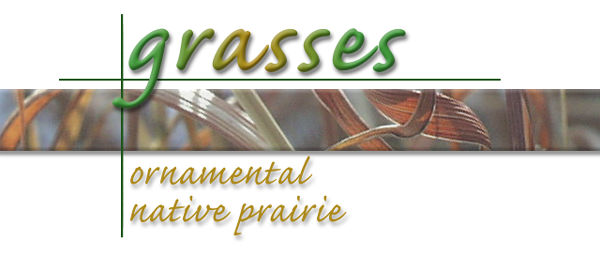
If it is true that, "one thing leads to another," then growing african violets in small clay pots on a windowsill has led eventually to caring for a garden that is home to six foot tall clumps of Big Blue Stem. This is a truncated but nontheless accurate description of my evolution as a gardener. I still grow plants in pots. Large pots of a variety of tropical perennials summer out doors and spend the winter cheek by jowl in a small but lush green house. Although I grow one variety of non-hardy ornamental grass, the rest of the Native and ornamental grasses grow in ever enlarging beds around my house. I remember many years ago watching a clump of six foot tall grass grow in my neighbors yard. As gardeners do, when I commented on the loveliness of the grass, my neighbor offered me as big a clump as I wished to dig up for myself. That was the beginning of my affair with grasses. Now I was stuck because back 15 years ago the written information on grasses was very hard to find, and much of it was not written for the average gardner. I searched local bookstores, and bought what I could find. No "amazon.com" at that point. As I searched for information, I also searched for as many varieties of grasses as I could find. This too was difficult for most garden centers had not heard of ornamental grasses. Catalogues carried no seeds for these grasses. Little by little this has changed until now, there is a decent amount of information at hand and a better selection of grasses available. Up until this point, which was about 10 years ago, I was on the hunt for as many varieties of "ornamental" grasses as I could find. The more I learned about grasses, the more I realized that I was going to have to broaden my descriptive adjectives. Ornamental - Native - Prairie - Reclamation - Forage These are just a few of the ways to describe grasses. There is hardly a category in which one could not find a few, if not many grasses. Grasses are annuals, perennials and biennials. Some grasses grow in shade and some in sun. Some are low growing mat forming and some grow quite tall. Grasses vary in growth habit as well as temperature requirements. There are grasses that grow in water and those that tolerate drought well. Some grasses are particularly good at stabilizing soil and some have been known for thousands of years as good forage. There are over 8,000 species in this family of flowering plants (Gramineae / Poaceae) that we commonly call grasses. Included are plants such as rice, barley, sugar cane, corn, wheat and all of the Bamboos. Indeed the timber bamboos are probably the largest growing members of this family, some reaching more than 60 feet. As I began thinking more broadly about grasses, I found myself looking for more. I had planted some varieties of Miscanthus and Pennesitum, but as I read I began to think more about the kinds of grasses that made up the great grasslands of this country. The Grasses of the Prairies As I read more about grasses, their history and culture, I began to wonder what it would be like to live with some of the native grasses of this continent. I had heard of some of them by name, but knew nothing else about them. As fortune sometimes does, she smiled upon me, and a catalogue arrived from a company called Plants of the Southwest, located in New Mexico. This company offered seeds of many of the indigenous grasses. Having tried my hand at growing a wide variety of plants from seed, I was anxious to grow some of these grasses. Fast forward a few years and I now have a garden that I seem to have to enlarge every spring to accommodate another variety of grass. To date these are the grasses that I have been able to grow successfully from seed and have watched flourish for about four years in the garden.
NOTE:The grasses above that are hyperlinked go to the "Index of Species Information" of grasses on the Graminoid List provided by:
For each species of grass, this site gives the following information: Distribution and Occurence - Value and Use - Botanical and Ecological Characteristics - Fire Ecology - Fire Effects - References Grasses in Flower My grass garden will never resemble a prairie, nor will it ever become a meadow. I grow these plants so that I can become familiar with them and to see if in fact they can adapt to a location that is fairly far removed from the plains grasslands. I live and grow these grasses in SE Pennsylvania. I am a photographer as well as a gardener and the combination of the two provides endless enjoyment for me. I have started to photograph the grasses as they come into bloom. I have photographs of the following in flower:
|
Page last updated September 26, 2002
Return to Index
Return to Garden page